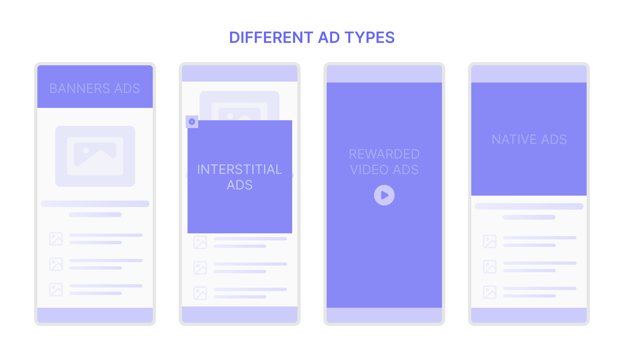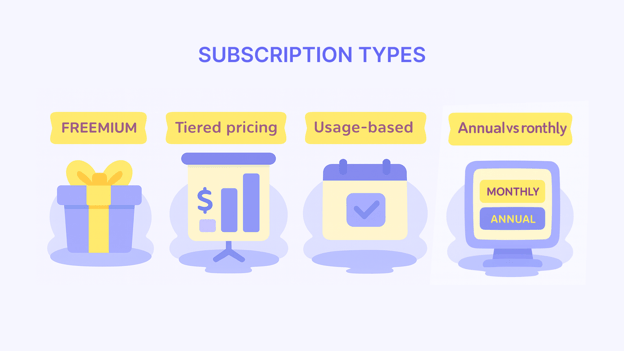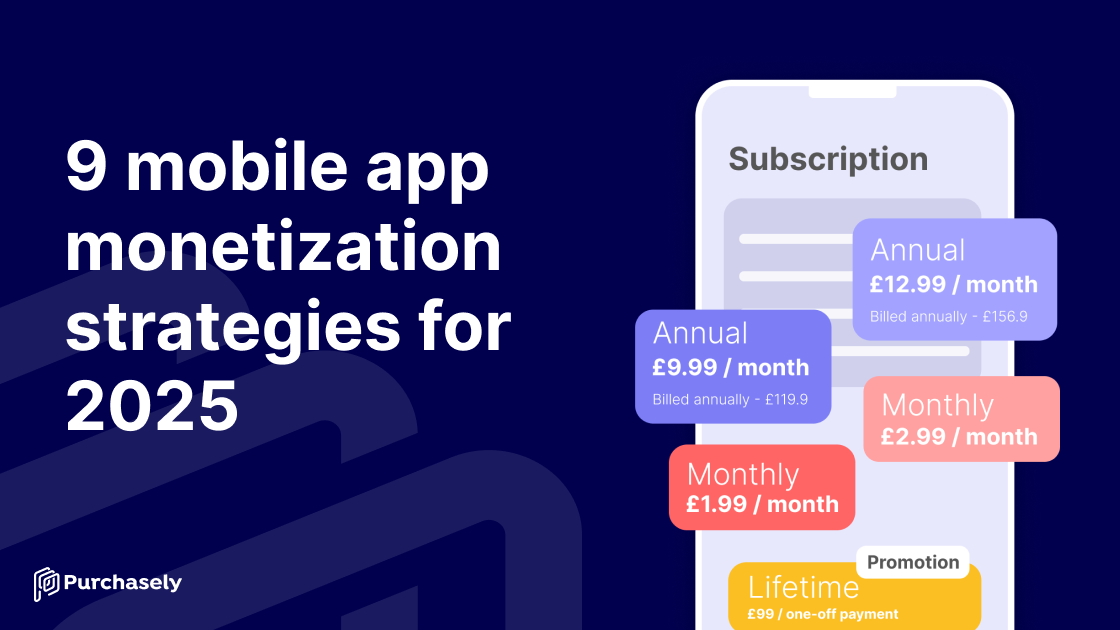Here’s the hard truth: even with the mobile app economy on track to hit $390 billion in revenue by 2025, most apps don’t make real money.
In fact, over 95% of apps struggle to generate sustainable revenue — and only a tiny fraction break through to significant success.
For enterprise product managers and growth marketers, the pressure is building.
And in today’s market, what worked in 2022 won’t cut it in 2025.
That’s why we created this guide: to give you a clear, actionable, and up-to-date roadmap for building app revenue that lasts.
What is mobile app monetization?
Mobile app monetization is how app creators make money from their apps. Instead of just building an app and hoping people will pay for it, smart developers use different methods to earn revenue from their users.
Think of it like running a business. You need to find ways to make money while giving your customers something valuable.
The best apps do this by offering great experiences and charging for premium features, showing ads, or selling subscriptions.
The main ways apps make money include:
-
Showing ads to users
-
Selling premium features or content
-
Offering monthly or yearly subscriptions
-
Letting users buy virtual items
-
Partnering with other businesses
Why mobile app monetization matters
Today's users expect apps to be free to download. This means you can't just charge people upfront anymore. You need to give them value first, then find ways to make money after they start using your app.
Mobile users spend 90% of their time in apps compared to just 10% browsing websites.
This creates huge opportunities for app owners who know how to monetize effectively.
In short, good monetization strategies help you:
-
Create steady income for growing companies
-
Keep customers longer and increase their value
-
Combine revenue from different platforms
-
Set your app apart from competitors through smart pricing
The key is finding the right balance. You want to make money without annoying your users or making them feel like they're being forced to pay.
The current mobile app monetization landscape
The mobile app industry is bigger than ever, and it keeps growing fast. Understanding the current market helps you make better decisions about how to monetize your app.
Market size and growth
The numbers are impressive. Mobile apps generated over 171 billion U.S. dollars in annual revenues in 2023, and ad spending in this market projected to reach $390 billion worldwide by 2025.
Here's what makes these numbers even more interesting.
The industry is expected to maintain steady growth, with a compound annual growth rate (CAGR) of 8.17% from 2025 to 2029, resulting in a market value of approximately $533.90 billion by 2029.
This growth isn't slowing down. User spend on recurring subscriptions is projected to reach nearly $1.26 trillion by the end of 2025. That's a massive opportunity for apps that can build loyal, paying user bases.
How apps make money today
The way apps monetize has changed dramatically over the years. While 77% of apps in the Apple App Store were paid apps in 2009, only 4.9% currently require payment at download.
Meanwhile, in the Google Play Store paid apps account for only 3.01% of all mobile apps.
This shift happened because users got used to downloading apps for free. Now, successful apps use different strategies:
Most popular monetization methods:
Source: Statistica
Free apps dominate: Over 95% of apps on Google Play and Apple Store were offered to download for free as of January 2025. This means almost every app needs a plan to make money after users download it.
9 proven mobile app monetization strategies
Now let's dive into the specific ways successful apps make money. Each strategy works differently, and the best apps often combine several methods to maximize their revenue.
1. In-app advertising
For many mobile apps, ads are the fastest way to start generating revenue — especially if you have a decent user base but no clear paid offering yet. In-app advertising (IAA) works by displaying ads to users while they engage with your app, earning you money based on impressions, clicks, or conversions.
And it’s not a small game. As mentioned, with global ad spend in mobile apps expected to hit $390 billion in 2025, it makes it the single largest source of app revenue worldwide. In fact, in-app ads perform over 11 times better than mobile web banner ads, thanks to better targeting and native integration.
Common ad formats to consider
Choosing the right ad format is key. Each comes with its own balance of user experience, engagement, and revenue potential:
-
Banner ads: These are simple, persistent ads at the top or bottom of the screen. They offer low CPMs but steady exposure.
-
Interstitial ads: Full-screen ads that appear at natural transition points, like after a game level. They tend to have high engagement and CPMs over $10.
-
Rewarded video ads: These let users choose to watch an ad in exchange for something — like extra lives, coins, or content. They feel less intrusive and often increase retention.
-
Native ads: These match the app’s design and appear more like organic content. While click-through rates are low (around 0.38%), they outperform traditional banners significantly.

Getting implementation right
The success of your ad strategy comes down to smart implementation. Here’s what to focus on:
-
Choose the right platform: AdMob (Google), Unity Ads (popular for gaming), and AppLovin are all strong choices, depending on your app category.
-
Balance monetization and UX: Poorly timed or excessive ads can tank retention. Use frequency caps, smart placements, and test for drop-off points.
-
Pick your revenue model: You’ll likely use one or more of the following — CPM (cost per thousand impressions), CPC (cost per click), CPI (cost per install), or CPA (cost per action).
Best practices that actually work
Want to earn more without annoying your users? Follow these:
-
Use strategic timing: Place ads during natural breaks, not when users are deeply engaged.
-
Control quality and relevance: Opt into brand-safe ad networks and filter by category to avoid jarring user experiences.
-
Track performance: Monitor click-through rate (CTR), eCPM, and fill rate to understand what’s working — and optimize continuously.
2. In-app purchases
In-app purchases (IAPs) remain one of the most powerful monetization tools for apps — especially in gaming, lifestyle, fitness, and content-based apps. Why? Because they let users unlock extra value at exactly the moment they’re most engaged.
The market is booming. In 2024, IAPs were valued at $209.13 billion, and that’s projected to grow to $257.23 billion by the end of 2025. Even more telling: nearly half of all mobile app revenue now comes from in-app purchases.
Types of in-app purchases
There are three main types of IAPs, and the right mix depends on your app’s experience and user goals:
-
Consumables: One-time use items like coins, extra lives, or power-ups. Great for gaming and gamified utilities.
-
Non-consumables: Permanent unlocks — think ad removal, premium themes, or one-time content packs.
-
Subscriptions: Recurring access to premium features, content libraries, or enhanced functionality.

Strategies for increasing IAP revenue
If you want users to buy, you need to make it feel easy, worthwhile, and timely. Here’s how:
-
Use behavioral triggers: Prompt purchases when users reach milestones or run into natural friction.
-
Clarify the value: Make it instantly clear what users are getting — and why it’s worth paying for.
-
Play with pricing psychology: Try bundling, decoy pricing, and charm pricing ($4.99 vs $5.00).
-
Refine your conversion funnel: Test placement, timing, and language to remove friction and hesitation.
Things enterprise teams should watch for
IAPs offer strong upside — but there are a few backend considerations you need to manage well:
-
App store commissions: Apple and Google both take 15–30%.
-
Payment infrastructure: You’ll need to handle refunds, failed payments, and currency settings.
-
Data tracking: Use tools like RevenueCat, Amplitude, or Purchasely to monitor LTV and behavior.
3. Subscription models
If you’re aiming for predictable, recurring revenue, subscriptions are your best bet. They’ve quickly become the dominant model for everything from productivity apps to streaming platforms, and in 2025, user spending on app subscriptions is projected to hit $1.26 trillion.
Subscriptions give product teams the ability to forecast revenue, invest in long-term value, and build stronger retention loops — which is why they’re so popular with B2B SaaS and consumer-facing apps alike.
Subscription types to consider
There’s more than one way to set up a subscription model. Here are the most common options:
-
Freemium subscriptions: The core product is free, but users can upgrade for extra features.
-
Tiered pricing: Different pricing levels with increasing value.
-
Usage-based billing: Customers pay based on how much they use the app.
-
Annual vs monthly: Offering both lets you experiment with price sensitivity and LTV.

Keys to subscription success
It’s not enough to get users to subscribe — you have to keep them engaged long enough to stay. Here’s what matters:
-
Consistent value delivery: Make sure users feel the benefit regularly.
-
Smart trials: A 7- to 14-day trial often converts best.
-
Onboarding design: Highlight premium features during onboarding — even in the free tier.
-
Retention workflows: Use email, in-app messages, and helpful nudges to reduce churn.
Subscriptions aren’t just about locking users in. They’re about building a relationship where users choose to stay — because the app becomes part of their daily life.
4. Freemium model
Freemium remains the go-to model for most consumer-facing apps, and for good reason. It removes the friction of entry, builds trust with users, and creates natural upgrade opportunities once value has been demonstrated.
Today, around 95% of apps on the App Store and Google Play are free to download. Spotify is a prime example of freemium done right: with 675 million monthly active users, it converted over 260 million into paying subscribers — growing paid users 11% year-over-year.
How the freemium model works
The key is striking a balance between what’s free and what’s worth paying for. Here’s the typical setup:
-
Free tier access: Users get core features without payment or credit card entry.
-
Premium feature gating: More advanced or desirable features are locked behind a paywall.
Upgrade nudges: Timed prompts, usage limits, or added convenience push users toward paid plans.
Freemium works best when the free version solves a real problem, and the premium version offers obvious value on top of that.
Implementation strategy
Launching a freemium model takes more than flipping a switch. You need to design around user experience and value delivery:
-
Segment your features: Map out which features drive engagement and which drive revenue.
-
Test conversion pathways: Try different upgrade prompts, messages, and triggers.
-
Analyze free vs paid usage: Look at how free users behave differently — and what actions lead to upgrading.
A good freemium strategy doesn’t just maximize conversions. It also builds brand affinity by giving users a reason to stick around, even before they pay.
5. Paid app downloads
Charging users upfront used to be the norm. But with today’s crowded app landscape and the rise of freemium and ad-supported models, paid downloads have become a niche approach — and one that requires very specific conditions to succeed.
Globally, only about 3% of apps monetize through paid downloads, and in the U.S., it’s only slightly higher at 7%. That said, these apps often attract more serious, loyal users — and tend to see higher engagement rates.
When the paid model works
Paid downloads are best suited for apps that meet one or more of these criteria:
-
Strong brand recognition: Users already know and trust what you’re offering.
-
Unique value proposition: Your app solves a high-stakes or specialized problem.
-
Niche markets: If you’re targeting a tight audience with specific needs, paying upfront may feel normal.
Premium positioning: Paid pricing can reinforce exclusivity or professionalism — especially in B2B or education.
Challenges to watch out for
Going paid-first creates a high barrier to entry, which means:
-
User acquisition is harder: You’ll likely need to invest more in marketing and education to convince users to buy.
-
No try-before-you-buy: Without a free trial or preview, many users will hesitate — or bounce entirely.
-
App store competition is fierce: With so many free alternatives available, your offer needs to stand out immediately.
In short, the paid model isn’t dead — but it’s selective. If your app fits the mold, it can work well. Otherwise, you’re probably better off combining free access with strong in-app monetization.
6. Sponsorship and partnership models
For some apps, direct monetization from users isn’t the only path to revenue. Sponsorships, brand partnerships, and affiliate deals can unlock high-value revenue streams — especially when your app reaches a specific audience that advertisers want to engage with.
Rather than relying on ads or in-app purchases, this model involves working with other businesses to provide value to users while generating income in the background.
Revenue opportunities
There are several ways to turn partnerships into profit:
-
Branded content and product placements: Integrate a partner’s brand or messaging directly into the app experience.
-
Cross-promotional campaigns: Promote each other’s offerings within your respective ecosystems.
-
Affiliate links and commissions: Send users to partner products and earn a percentage of sales.
White-label licensing: Package your app for partners to rebrand and offer to their own audiences.
This approach can work especially well for fitness, wellness, education, and content-driven apps with loyal, niche audiences.
How to implement effectively
Strong partnerships require clear value alignment and seamless execution. Focus on:
-
Strategic partner selection: Work with brands that complement your mission and appeal to your audience.
-
User-first integration: Make sure sponsored content feels native, helpful, or additive — not disruptive.
-
Performance tracking: Use UTMs, referral links, or in-app analytics to monitor conversion, engagement, and ROI.
When done right, partnerships don’t just drive revenue — they can also enhance user trust and broaden your reach.
7. Data monetization
Data monetization is a rising but often misunderstood revenue model. Done ethically and with user consent, it can provide valuable income streams, especially for apps that generate large volumes of behavioral or usage data.
This strategy typically involves turning anonymized user insights into actionable intelligence for other companies, researchers, or platforms.
Emerging monetization methods
There are several ways to extract value from data while maintaining trust and compliance:
-
Behavior analytics: Offer insights into app usage trends, engagement patterns, or user behavior.
-
Market research partnerships: Work with agencies that need real-world usage data to validate trends.
Trend reporting services: Aggregate data into industry reports or dashboards for subscription access.
Data-as-a-service (DaaS): Sell anonymized datasets to vetted partners via APIs or platforms.
Privacy and compliance best practices
With growing regulation around user data, the key is transparency. Always:
-
Anonymize and aggregate: Never share individual user data or identifiable information.
-
Follow GDPR, CCPA, and local laws: Stay current with regional requirements and consent protocols.
-
Give users control: Let them opt in (or out) of any data collection beyond what’s essential to your app.
Data monetization isn’t for every app. But for those that can implement it responsibly, it offers an increasingly valuable revenue stream.
8. Hybrid monetization approaches
In today’s market, the most successful apps don’t rely on just one revenue model — they combine multiple. This hybrid approach spreads risk, improves LTV, and gives users more ways to engage with your app based on their preferences.
It’s common to see apps mix freemium access with in-app purchases and rewarded ads. Or offer both subscription and one-time upgrade options. Flexibility is the new standard.
Why hybrid works
A layered strategy lets you:
-
Capture different user segments: Some users will pay, some will click ads, others just want to try.
-
Increase total revenue per user: Offering multiple ways to spend often boosts ARPU.
-
Adapt to market changes: You’re not stuck with a single stream if trends shift or regulations change.
Building your hybrid stack
Think of monetization like product design — each layer should make sense on its own and together:
-
Start with your core: Is it value-driven (subscription)? Attention-driven (ads)? Access-driven (IAP)?
-
Add complementary layers: Rewarded ads alongside freemium, or IAP within subscriptions.
-
Test and refine: Watch for friction, cannibalization, or drop-offs. Optimize based on behavior and feedback.
Hybrid monetization is a great strategy when executed well because it leads to more stable, diversified revenue growth.
9. Enterprise and B2B models
For B2B SaaS and enterprise mobile products, the monetization playbook looks a bit different.
These apps typically don’t rely on ads or freemium. Instead, they focus on structured pricing, value-based billing, and scalability across large teams or organizations.
These models work best when your app is part of a larger workflow or solves a high-value business problem.
Common enterprise monetization methods
Enterprise apps tend to use more formal pricing and contract structures, including:
-
Per-seat licensing: Charging based on the number of users or team members accessing the platform.
-
Usage-based pricing: Billing based on activity — API calls, content usage, data volume, etc.
-
White-label solutions: Custom-branded versions of the app sold to partners or clients.
-
API access plans: Charging for integration or automation access through usage tiers or SLAs.
Keys to enterprise success
Selling into businesses requires a different mindset than consumer monetization:
-
Custom pricing flexibility: Be ready to tailor plans based on size, needs, and procurement processes.
-
Integration readiness: Your app should work well with CRM, ERP, or BI tools used by clients.
-
Security and compliance: Enterprise buyers will expect SOC 2, ISO, and GDPR compliance out of the box.
Dedicated support and onboarding: Long-term retention often depends on the first 90 days of implementation.
For teams building B2B or vertical-specific apps, the enterprise model offers the most reliable path to large, recurring contracts — and long-term customer value.
Some monetization best practices to keep in mind
Choosing the right monetization model is only half the battle.
What separates high-performing apps from the rest often comes down to execution aka how smoothly you guide users through value, pricing, and purchase decisions.
These best practices can help you build a revenue engine that actually works.
Start with monetization at the product design stage
One of the biggest mistakes app teams make is treating monetization as an afterthought. It gets pushed until after launch, tacked on when growth slows, or wedged in around existing user flows — usually with poor results.
The best-performing apps think about monetization from the beginning. That doesn’t mean building a paywall on day one. It means designing user journeys, feature sets, and upgrade paths that naturally lead to a purchase moment.
When monetization shapes product decisions early, it feels like part of the experience — not a distraction from it.
Reduce friction in your paywall flow
Paywalls aren’t just gates, they’re conversion tools.
And if they’re clunky, confusing, or badly timed, they can kill your revenue before it starts. Users should immediately understand what they’re getting, why it matters, and how much it costs. No guessing, no unnecessary steps.
With Purchasely, teams can build high-performing paywalls without writing a single line of code.

You can run A/B tests on layout, copy, pricing, or trigger timing and deploy changes instantly. That means you're not locked into guesswork.
You can continuously learn, adapt, and optimize your paywall based on what actually drives conversion.
Design onboarding that showcases premium value
Most users decide whether your app is worth paying for in the first few minutes. That’s why onboarding isn’t just about setup. It’s your best chance to highlight what makes your premium experience valuable.
With Purchasely, you can create personalized onboarding flows that adapt to different user segments or behaviors. No developer backlog required.

Want to spotlight a specific feature for new users? Or run a variant with a different upsell moment?
You can test and deploy those flows in real time, helping more users move from curious to committed.
Mix monetization methods to boost LTV
No single monetization model works for every user. Some will pay for subscriptions, others prefer one-off purchases, and plenty won’t pay at all, but might engage with rewarded ads.
A hybrid strategy helps you meet each user where they are, without forcing a one-size-fits-all approach.
When done right, combining models can significantly increase lifetime value. Think freemium with IAPs, or subscriptions alongside optional upgrades. Just make sure each layer feels intentional. Too many monetization prompts, or poorly timed ones, can do more harm than good.
Final thoughts
Mobile app monetization in 2025 is no longer about picking a single revenue model and hoping it works. The most successful apps are those that treat monetization as a product experience: one that’s tested, optimized, and built around the needs of real users.
New to Purchasely?
Purchasely helps mobile apps and B2B SaaS teams grow revenue through smarter, faster, and more flexible monetization tools. From native paywall A/B testing to personalized onboarding flows, our platform makes it easy to build and optimize your in-app purchase experience — without relying on engineering.
Ready to turn your monetization strategy into results?
Book a demo with our team and see how leading apps are using Purchasely to increase conversion, reduce churn, and boost lifetime value.






